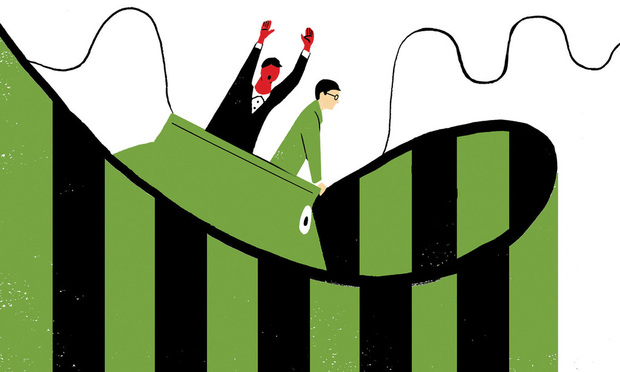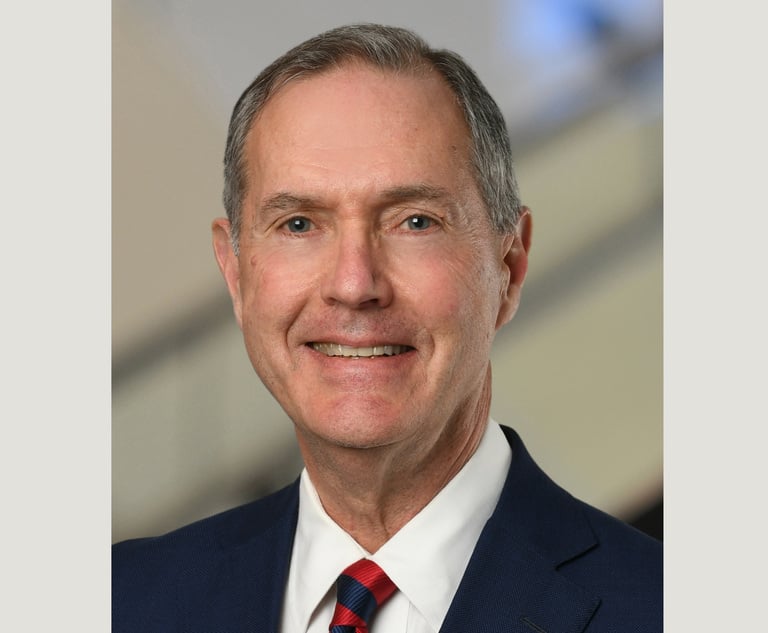Volatility Is Now a Fact of Life for America's Biggest Firms
Rollercoaster performances from year to year are becoming the norm, especially at the top of the Am Law 100.
April 24, 2018 at 09:52 AM
9 minute read
 Credit: Hanna Barczyk
Credit: Hanna Barczyk
With all the talk about how the Am Law 50 are significantly outperforming the rest of the nation's largest firms, it can be a bit daunting for those at No. 51 and below to find reasons to be hopeful about their place in the market. But don't let stratification get you down. There is a growing trend in Big Law that impacts the nation's most profitable firms more acutely than any other segment: volatility.
 Looking to buy the report or leverage the Am Law 100 data with powerful data visualizations and expert analysis? Access Premium Content
Looking to buy the report or leverage the Am Law 100 data with powerful data visualizations and expert analysis? Access Premium ContentEqual parts strategy, fiscal management and psychology, leaders of Am Law 200 firms are increasingly having to manage unpredictable financial returns from one year to the next. Talk about adding stress to the budgeting process.
Volatility can come in a number of forms. At Citi Private Bank Law Firm Group, volatility is measured by a fluctuation from year to year in demand, or billable hours logged by all timekeepers. A firm experiences volatility if it sees a rise in demand one year and a decrease the next, or vice versa.
Gretta Rusanow, head of advisory services for the Law Firm Group, says 45 percent of the 143 firms Citi surveyed experienced volatility between their 2016 and 2017 results, up from 42 percent that said the same between 2015 and 2016.
Ever since 2010, that variation has been a usual and growing part of law firm life, Rusanow says. And it's not something that would get the bank concerned about a firm's financial health.
“We view that zig-zag performance as a characteristic of the industry,” Rusanow says. “What we would look at more carefully is multiple consecutive years of decline, as well as movement among the partnership.”
If ever there was a barometer for whether a trend was acceptable, it is how it impacts the most profitable law firms. If they are experiencing volatility, it can't be bad, right?
“The fact that even the most profitable firms experience volatility—and in fact a little more acutely than the rest of the industry—supports that,” Rusanow says.
One leader of an Am Law 50 firm who didn't want to be named says there is no question volatility is impacting every firm in the market. It's just a matter of how those firms are managing it.
“None of us are getting a huge percentage of our revenue from repeat institutional clients the way we all did 20 years ago or even 10 years ago,” he says. “That is a form of volatility in itself because you have to replace work every year, every six months, every two years.”
If firms have a good run, that volatility comes in the form of changing clients, not changing revenue, the leader says. But for a “huge percentage” of firms, volatility is coming in the form of revenue fluctuations because replacing big matters is challenging and unpredictable, he says.
And it's those large cases or deals—the kind clients may have only once or twice every few years—that are the most difficult to replicate and plan for, according to the firm leader, who notes those are the cases the biggest, most profitable firms are going after.
“If your place in the market is at a lower price point, where you are chasing a chunk of the disaggregated, repetitive work that is lower margin but more predictable and more regular in flow, then I think you'll see less of the volatility,” he says. “If your practice is high-rate, looking for the most profitable matters, I think you will see more volatility because those matters are less predictable.”
In the time before the Great Recession, predictability meant guaranteed growth year over year for firms, even though no other business operates that way, Altman Weil consultant Tom Clay says.
“The legal profession has always felt like they have had some kind of a birthright for steady up years in every year,” Clay says, noting that “there is this thought that 'we were flat last year, we are going to hell.'”
Volatility will be the norm going forward, Clay predicts. It would be one thing if firms could return to the days of unfettered billing-rate increases or tell alternative legal services providers to back out of the market, but those ships have sailed, he says.
The legal industry is “moving out of fairyland into reality,” Clay says.
For law firm leaders, this new market normal requires some finessing with their partnerships.
Psychological Management
Rusanow says Citi started tracking volatility because its analysts were increasingly asked at partner retreats to offer a multiyear perspective on firm finances rather than just one year. Her team is educating partners on the realities of the new market and what a good year now looks like. The law firm leader says managing to volatility takes some strategic planning along with the right messaging to partners.
“On the front end, you are trying to build your bench so that you have as many partners as possible who have the ability to generate those [big, high-dollar] matters. Where in the past you may have had a smaller group, you are trying to build that group,” he says.
Firms must acknowledge volatility's existence and talk about performance over a longer period of time. A firm isn't as bad as its worst year or as good as its best.
“If you do too much of telling your partner, 'Hey, look, it's the new us. We have all these big matters,' and then you don't have it the next year, what happened? Well, nothing happened,” he says. But it might not be perceived that way.
Though this firm leader would argue a five- to 10-year view of finances best demonstrates a firm's health, he acknowledges that the biggest window any firm management might be allowed is about two to three years.
Just Not From My Wallet
When it comes to the sentiment of a partnership, there is acceptable volatility and unacceptable volatility. Partners generally will live with a decline in billables or revenue, consultants and firm leaders say, just as long as their annual profits don't dip.
At the many law firm partner retreats Clay has attended, he says there is inevitably a chart that shows a decline in billable hours, but it's quickly followed by another that shows a slight uptick in partner profits.
“There isn't enough pain for the partners to worry about the broader picture,” Clay says, but law firm leadership should be cognizant of the trends.
Volatility is always controlled by how a firm manages itself, he says.
“Other businesses don't suffer overcapacity very long, and law firms do,” Clay says. “So law firms won't rise and fall, except for those firms that have really turned to an alternative staffing methodology that allows them to vary with the demand.”
But from the Am Law 50 law firm leader's perspective, there is little more firms can do that they haven't already done to grow profitability in a low-growth environment. That is, of course, unless a firm is increasing revenues, the leader says. Firms can only cut so many partners, redo their real estate so often and outsource back-office operations so many times.
“If revenue isn't growing, there is a ceiling, unless you profitability yourself out of existence. 'The one remaining partner had a really good year,'” the law firm leader jokes.
What Volatility?
Not all market observers are buying into the volatility hype. David Barnard of Blaqwell Inc. says he thinks many analysts who predicted tough years for 2017 got it all wrong as more firms posted gains than in several years prior.
And firms are becoming smarter about managing volatility. Big contingency fees, which he says were a driver of big swings in firm revenue and profits, are becoming less frequent. When firms do handle contingent cases, they are using litigation funders to help smooth out the financial impact. In general, Barnard says, law firms are better managed than they used to be and quicker to respond to declines in revenue and profitability.
Barnard isn't blind to market trends of lowered demand and increased competition from third-party providers. He acknowledges those will cause some winners and losers in the law firm space. But, he says, on the whole the economy is growing at a faster clip than the country has seen in several years and deregulation will be good for lawyers. Other market trends bode well for firms, too, Barnard says.
“A lot of law firms are going to feel very empowered to increase their rates this year because they made a lot of money [in 2017],” Barnard says. “The pendulum seems to have swung away from general counsel. General counsel protested too much. … Nobody is going to put their best lawyers to work for banks [for example] because they are too cheap.”
Barnard doesn't see the biggest law firms shrinking. In fact, he still anticipates a few more years of growth. And who knows, volatility may end up being a passing trend that has already seen its final days. The number of firms posting strong gains last year, coupled with a positive outlook for 2018, may mean the industry will be talking about continued growth trends next year. But, as Rusanow, Clay and others point out, crystal ball gazing for the legal industry is becoming an increasingly difficult thing to do.
Email: [email protected]
This content has been archived. It is available through our partners, LexisNexis® and Bloomberg Law.
To view this content, please continue to their sites.
Not a Lexis Subscriber?
Subscribe Now
Not a Bloomberg Law Subscriber?
Subscribe Now
NOT FOR REPRINT
© 2025 ALM Global, LLC, All Rights Reserved. Request academic re-use from www.copyright.com. All other uses, submit a request to [email protected]. For more information visit Asset & Logo Licensing.
You Might Like
View All
Law Firms Look to Gen Z for AI Skills, as 'Data Becomes the Oil of Legal'

Losses Mount at Morris Manning, but Departing Ex-Chair Stays Bullish About His Old Firm's Future
5 minute read

KPMG's Bid to Practice Law in U.S. on Indefinite Hold, as Arizona Justices Exercise Caution
Trending Stories
- 1Uber Files RICO Suit Against Plaintiff-Side Firms Alleging Fraudulent Injury Claims
- 2The Law Firm Disrupted: Scrutinizing the Elephant More Than the Mouse
- 3Inherent Diminished Value Damages Unavailable to 3rd-Party Claimants, Court Says
- 4Pa. Defense Firm Sued by Client Over Ex-Eagles Player's $43.5M Med Mal Win
- 5Losses Mount at Morris Manning, but Departing Ex-Chair Stays Bullish About His Old Firm's Future
Who Got The Work
J. Brugh Lower of Gibbons has entered an appearance for industrial equipment supplier Devco Corporation in a pending trademark infringement lawsuit. The suit, accusing the defendant of selling knock-off Graco products, was filed Dec. 18 in New Jersey District Court by Rivkin Radler on behalf of Graco Inc. and Graco Minnesota. The case, assigned to U.S. District Judge Zahid N. Quraishi, is 3:24-cv-11294, Graco Inc. et al v. Devco Corporation.
Who Got The Work
Rebecca Maller-Stein and Kent A. Yalowitz of Arnold & Porter Kaye Scholer have entered their appearances for Hanaco Venture Capital and its executives, Lior Prosor and David Frankel, in a pending securities lawsuit. The action, filed on Dec. 24 in New York Southern District Court by Zell, Aron & Co. on behalf of Goldeneye Advisors, accuses the defendants of negligently and fraudulently managing the plaintiff's $1 million investment. The case, assigned to U.S. District Judge Vernon S. Broderick, is 1:24-cv-09918, Goldeneye Advisors, LLC v. Hanaco Venture Capital, Ltd. et al.
Who Got The Work
Attorneys from A&O Shearman has stepped in as defense counsel for Toronto-Dominion Bank and other defendants in a pending securities class action. The suit, filed Dec. 11 in New York Southern District Court by Bleichmar Fonti & Auld, accuses the defendants of concealing the bank's 'pervasive' deficiencies in regards to its compliance with the Bank Secrecy Act and the quality of its anti-money laundering controls. The case, assigned to U.S. District Judge Arun Subramanian, is 1:24-cv-09445, Gonzalez v. The Toronto-Dominion Bank et al.
Who Got The Work
Crown Castle International, a Pennsylvania company providing shared communications infrastructure, has turned to Luke D. Wolf of Gordon Rees Scully Mansukhani to fend off a pending breach-of-contract lawsuit. The court action, filed Nov. 25 in Michigan Eastern District Court by Hooper Hathaway PC on behalf of The Town Residences LLC, accuses Crown Castle of failing to transfer approximately $30,000 in utility payments from T-Mobile in breach of a roof-top lease and assignment agreement. The case, assigned to U.S. District Judge Susan K. Declercq, is 2:24-cv-13131, The Town Residences LLC v. T-Mobile US, Inc. et al.
Who Got The Work
Wilfred P. Coronato and Daniel M. Schwartz of McCarter & English have stepped in as defense counsel to Electrolux Home Products Inc. in a pending product liability lawsuit. The court action, filed Nov. 26 in New York Eastern District Court by Poulos Lopiccolo PC and Nagel Rice LLP on behalf of David Stern, alleges that the defendant's refrigerators’ drawers and shelving repeatedly break and fall apart within months after purchase. The case, assigned to U.S. District Judge Joan M. Azrack, is 2:24-cv-08204, Stern v. Electrolux Home Products, Inc.
Featured Firms
Law Offices of Gary Martin Hays & Associates, P.C.
(470) 294-1674
Law Offices of Mark E. Salomone
(857) 444-6468
Smith & Hassler
(713) 739-1250










